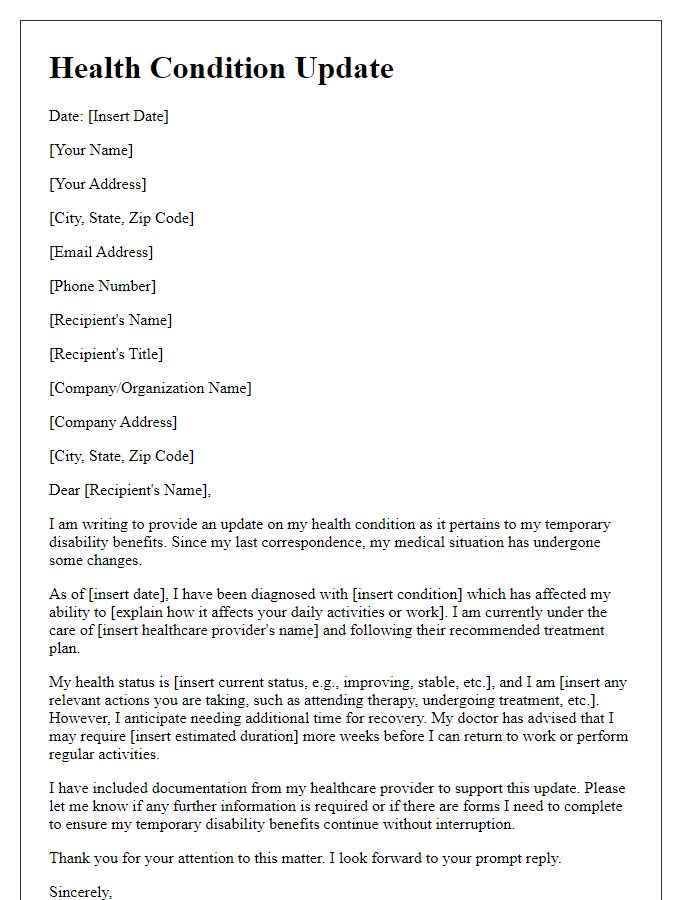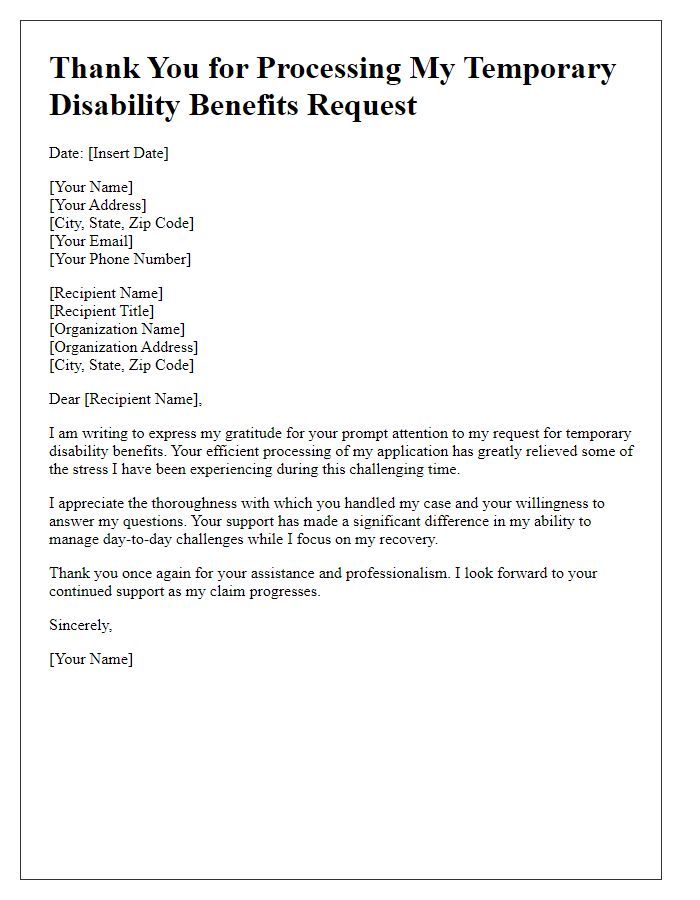Are you or someone you know facing challenges due to a temporary disability? Navigating the world of benefits can feel overwhelming, but understanding how to request temporary disability benefits can make a significant difference in your journey to recovery. In this article, we'll break down the essential elements of a successful letter template that you can use to communicate effectively with your insurance provider. So, grab a cup of coffee and let's dive in to help you get the support you need!

Personal Information
Filing for temporary disability benefits requires clear personal information. Essential details include full name, such as Jane Doe, and Social Security number, for identification. Address information, typically including street address, city, state, and zip code, is important for communication purposes. Contact information, including current phone number (e.g., 555-123-4567) and email address (e.g., janedoe@email.com), facilitates prompt updates regarding the application status. Lastly, the date of birth, such as May 15, 1985, is crucial for eligibility verification in association with specific disability regulations.
Medical Condition Details
Requesting temporary disability benefits requires a clear presentation of medical conditions affecting one's ability to work. For instance, a diagnosis of herniated disc can significantly impact mobility and cause chronic pain, leading to extended recovery periods often lasting several months. Specific medical treatments like physical therapy sessions, which typically occur two to three times per week, play a crucial role in rehabilitation. Additionally, medications prescribed, such as nonsteroidal anti-inflammatory drugs (NSAIDs), assist in managing pain and inflammation but may have side effects like drowsiness. Documentation from healthcare providers, including MRI results showing the severity of the condition and recommendations for a medical leave of absence, is essential to bolster the request for benefits. The legal framework surrounding temporary disability benefits varies by state, with some jurisdictions having specific requirements for documentation and proof of inability to perform job duties.
Doctor's Certification
Temporary disability benefits request requires proper documentation from a licensed medical professional. A doctor's certification typically includes details such as the patient's diagnosis, treatment plan, and estimated recovery time. Essential elements of this certification may involve the specific medical condition (e.g., severe back injury) causing the inability to work, appointment dates, and physical limitations outlined by the doctor. Furthermore, relevant guidelines from agencies like the U.S. Social Security Administration may influence the format and required information to validate eligibility for benefits. Accurate and detailed documentation expedites the claims process and ensures compliance with necessary eligibility criteria.
Duration of Disability
The duration of disability significantly impacts the eligibility for temporary disability benefits. Typically, benefits are applicable for a specified period, often ranging from several weeks to up to two years, depending on the medical condition and the state regulations. For instance, in California, temporary disability can last up to 104 weeks, while New Jersey provides up to 26 weeks for qualifying conditions. Documentation from healthcare providers, detailing the extent and anticipated length of the disability, is crucial for securing these benefits. Proper completion of forms and adherence to filing deadlines, usually within 30 days of the disability onset, ensures timely financial assistance during recovery periods.
Contact Information
A letter template for requesting temporary disability benefits should include essential contact information to ensure clear communication with the relevant benefit agency. This contact information typically incorporates the applicant's full name, a detailed residential address, and a reliable phone number, facilitating prompt correspondence. Additionally, including an email address can expedite the process, allowing for swift updates or clarifications. The agency's contact details should also be present, featuring their name, address, and phone number, ensuring the letter reaches the right department without delays. Such meticulous organization enhances the effectiveness of the request while demonstrating professionalism.
Letter Template For Temporary Disability Benefits Request Samples
Letter template of request for temporary disability benefits due to medical condition.

Letter template of application for temporary disability assistance following an injury.

Letter template of inquiry regarding temporary disability benefit eligibility.

Letter template of notification for temporary disability benefits claim status.

Letter template of formal request for extension of temporary disability benefits.

Letter template of submission for documentation related to temporary disability benefits.

Letter template of request for reconsideration of temporary disability benefits amount.

Letter template of update on health condition affecting temporary disability benefits.






Comments